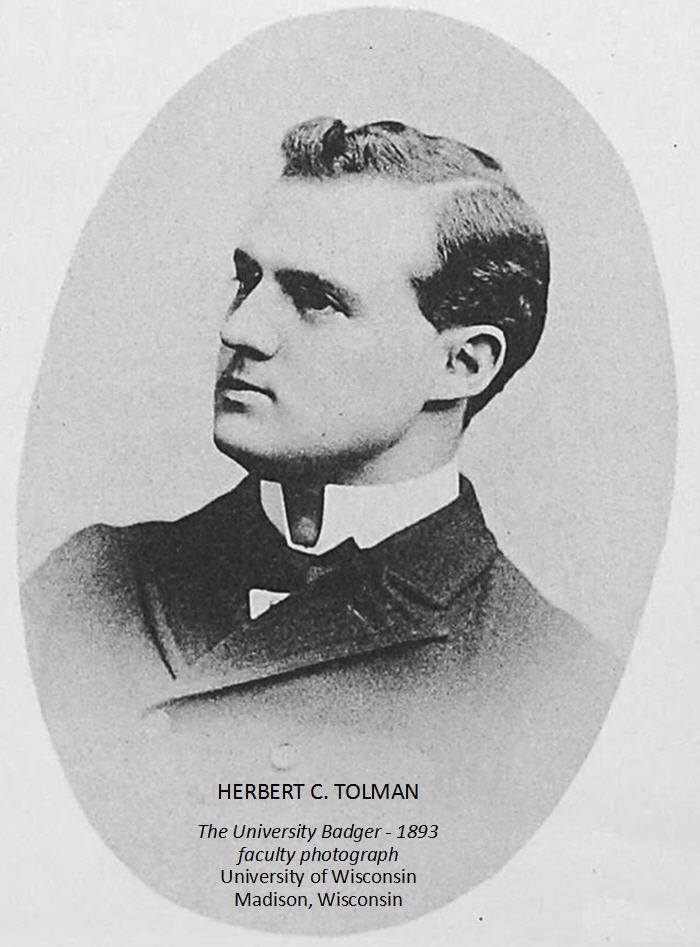Herbert Cushing Tolman
4 Nov 1865 – 24 Nov 1923
Son of James Turner & May Thomas Briggs Tolman
Herbert was born 4 Nov 1865. After attending the local schools he graduated from Rockland High School in 1884. He received his B.A. degree from Yale in 1888 and his Ph.D. from Yale in 1890. He was assistant in Euro-European languages at Yale in 1891 and an instructor in Latin at the University of Wisconsin, 1891-92. He remained there as assistant professor of Sanscrit during 1892-93. He was professor of Sanscrit and acting professor of Greek at University of North Carolina, 1893-94. He became professor of Greek at Vanderbilt University, Nashville, Tennessee in 1894. In 1914 he was appointed Dean of the College of Arts and Sciences at Vanderbilt, which position he held at the time of his death.
Soon after he went to Vanderbilt, Dr. Tolman was given a leave of absence to pursue his studies abroad, and in 1896 attended the University of Berlin, and again in 1905 was given leave of absence to attend the University of Munich. Previous to this time he had received his D.D. degree at Peabody College, and later, in 1913, received his S.T.D. from Hobart; L.L.D. from University of Nashville in 1913, and same degree from University of Louisville 1917. In 1913 was tendered the presidency of Hobart College but declined the offer.
In languages he was known internationally, and won signal recognition for his numerous works, especially in the field of ancient Persian, Greek and Sanscrit. He was an eminent scholar, and held membership in a number of organizations, both in the United States and abroad. He was Honorary Canon of All Saints Cathedral at Milwaukee from 1904, and member of the Royal Asiatic Society from 1924 until his death. He attended both the international Congress of Arts and Sciences at the St. Louis Exposition in 1904, and the Archeological Congress at Athens, Greece, in 1905. He was a lecturer of the Archeological Institute of America in 1912, and was in charge during several summers of Holy Trinity Church in Munich, Germany, Christ Church in Lucerne, Switzerland, and special preacher at old Trinity Church, in New York, on several occasions.
Dean Tolman was noted as an author of numerous works, and won high praise from a noteworthy British magazine for a treatise on cuneiform inscriptions. He was also the author of the following works: “Harper and Tolman’s Caesar’s Gallic War.” 1891; “Tolman’s Persian Inscriptions,”1892; “Kerr and Tolman’s Greek Gospel of Matthew,” 1892, “Harper’s Text Edtion of Caesar,” 1893; “Harrington and Tolman’s Greek and Roman Mythology,” 1897; “Tolman and Stephenson’s Herodotus and the Empires of the East,” 1899; “Art of Translating,” 1910; “Christi Imago,” 1915 Editor, “Vanderbilt Oriental Series” (nine volumes completed); Associate Editor of “World’s Progress” (ten volumes). One of his major works was “Ancient Persian Lexicon and Text,” giving the ancient Persian cuneiform inscriptions, followed by “The Cuneiform Supplement,” giving the cuneiform texts in the original. The former volume was published, together with an “Index Verborum,” written by Dr. E. L. Johnson.
Dr. Tolman was a thirty-second degree Mason, also a member of the Phi Beta Kappa honorary scholastic fraternity, and was President of the Vanderbilt Chapter of that order. His services as a priest in the Protestant Episcopal Church were sought by the leading parishes in America. Every summer he filled pulpits in the larger parishes of the East, and during the scholastic year he filled the pulpit at Christ Church on numbers of occasions. As a reader, Dr. Tolman had few equals, and his reading of the Episcopal service was impressive. As a lecturer he was known far and wide, and he had represented Vanderbilt as an exchange lecturer.
Dr. Herbert C. Toman died in Nashville 24 Nov 1923. On the occasion of the thirty-first anniversary of the founding of the Vanderbilt Chapter of Phi Beta Kappa by Dean Tolman, Vanderbilt University paid tribute to his memory. He was beloved as “teacher, scholar and friend” by hundreds of Vanderbilt men of past years. A bronze bust of the Dean was presented to the University by the Tolman Memorial Association.
Herbert Cushing Tolman married 26 Aug 1891 Mary B. Wells of New Haven, Conn. They had an adopted child, Mary Alice.
Copied from the Dictionary of American Biography; Vol. 18, p. 576-577
Tolman, Herbert Cushing;
b. 4 Nov 1865 South Scituate, Mass. D. 24 Nov 1923; Son of James Turner Tolman and Mary Thomas Briggs
Greek and Indo-Iranian Scholar, Author and Clergyman;
He attended grammar school in Hanover, Mass. To which the family removed when he was a boy, and high school at Rockland, Mass. In 1884 he entered Yale University and distinguished himself in Greek, Latin and Sanskrit and in 1888 received the degree of B. A. with high honors. In 1890 he received the degree of Ph. D. at Yale and became assistant to professor William Dwight Whitney (q.v.). The 26 Aug 1891 he m. Mary Beldon Wells, who with an adopted daughter survived him. He was instructor in Latin 1891-92 and assistant professor of Sanskrit 1892-93 at the U. of Wisc; Prof. Of Greek and Sanskrit 1893-94 at the U. of N. Car.; Prof. Of Greek at Vanderbilt U. 1894-1923; During his last 10 years at Vanderbilt he served as dean of the college of Arts and Sciences. He also taught for many years in the summer sessions of the George Peabody College. Numerous honorary degrees were conferred upon him. He studied at the U. of Berlin in 1896, at the U. of Munich in 1905. During his years of teaching and admin-istrative duties he was remarkable active in productive scholarship. He published 8 books of Caesars Gallic War (1891) with W. R. Harper:
A Grammar of Old Persian Language, 1892;
The Gospel of Matthew in Greek, 1892, with Alexander Kerr;
A Guide to the Old Prussian Inscriptions, 1893;
Greek and Roman Mythology, 1897, with K. P. Harrington, based on Herman Standings Griechische und Romische Mythologie;
Herodotus and the Empires of the East, 1899, with J. E. Stevenson;
The Art of Translating, 1901;
Mycenaen Troy, 1903, with G. C. Scoggin;
Ancient Persian Lexicon and the Texts of the Archaemenidan Inscriptions transliterated, 1908,
and a Cunneiform Supplement, 1910, to the latter.
To Tolman should be assigned also the Vanderbilt Oriental Series of 9 vols., for, aside from his own contributions, the whole series found its inspiration in him. In 1912 he was lecturer for the Archaeological Institute of America. He was Ass. Editor of the Worlds Progress (10 vols. 1911). He was a frequent contributor to such periodicals as the American Journal of Philology, the Journal of American Oriental Society and the American Journal of Archaeology. The wide recognition of his scholarship and attested by his being invited to contribute to the Madressa jubilee vol. Published in Bombay in 1914, for which he wrote, “The Grave of King Darius at Naksh-i-Rustam.”
In addition to his work in ancient languages he pub. 3 books on religious themes: Urba Beata, 1902; Via Crucis, 1907; Christi Imago, 1915; The last of these consisted of articles written for the Living Church of which he was devotional editor in 1914-1915.
Copied from Americana Encyclopedia, 1956 edition, vol. 26, p. 676;
Tolman, Herbert Cushing;
American Greek Scholar, b. South Scituate, Mass., 4 Nov. 1865; d. Nashville, Tenn., 24 Nov 1923;
He was graduated at Yale and studied at Berlin and Munich. He received his Ph. D., from Yale and was honored with the degree of D. D., from Peabody College and S. T. D., Hobart College, and L. L. D., University of Nashville. From 1894 he was head of the Greek department of Vanderbilt University and published several works on classical and philological subjects. His (Ancient Persian Language and Cuneiform Supplement) were adopted immediately after publication by the Universities of Germany and were recognized by foreign philological reviews as superseding what had yet been done in that line of research, while the American Journal of Philology and the New York Nation spoke of the author as the leading American Authority in the field of ancient Persian language. He was the first to identify positively the hitherto unknown season of the Persian month Garmapada, with June – July, an identification of great value to historians in fixing accurately several important dates. Dr. Tolman was elected president of Hobart College in 1913 but declined. In 1915 he was appointed dean of the College of Arts and Science of Vanderbilt University.
Tolman, Herbert Cushing:
Though reared a Congregationalist he became a member of the Protestant Episcopal Church and studied theology while at the U. of Wisc.; In 1895 in Milwaukee he was ordained Deacon and Priest. While never a Rector, he served frequently in the pulpit and had temporary charges of churches both in the U. S. and abroad. From 1904 he was an honorary Canon of all Sts. Cathedral of Milwaukee. He was distinguished for his diversity of his gifts, he was described after his death as, “a scholar of rare attainments, a teacher by instinct and by training, an admini-strator of courage and courtesy, a preacher of eloquence and power.”
References:
Evening Tennessean and American (Nashville) 24 Nov 1926;
Nashville Banner, 25 Nov 1926;
Nashville Tennessean, 25 Nov 1926;
Dwelley and Simmons, History of the Town of Hanover, Mass.; 1910;
Who’s Who in America, 1922-1923;
Yale University Obituary Record 1924;
In Memoriam; Herbert Cushing Tolman (privately printed 1926);
Obituaries in Living Church, 1 Dec 1923
Visit FamilySearch to learn more about Herbert Cushing Tolman. Visit the Thomas Tolman Family Organization to find out how you can get more involved in family history.


